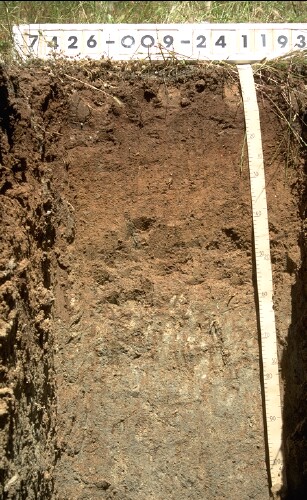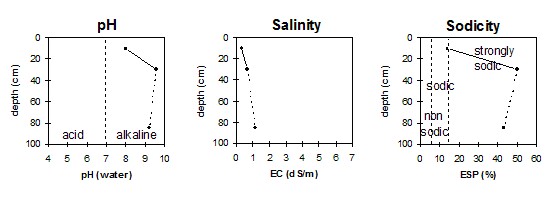MP30
| Group: Birchip Cropping Demonstration Group | Australian Soil Classification: Episodic-Epicalcareous, Epipedal, Yellow VERTOSOL |
| Northcote Factual Key: Ug 5.3 | Great Soil Group: brown clay |
| General Landscape Description: Flood plain within the Tyrell Creek Landsystem (Rowan and Downes, 1963). | |
Soil Profile Morphology:
Surface Soil
| A1 | 0-20 cm | Strong brown (7.5YR4/6); medium clay; surface cracking; very firm consistence dry; pH 8.0; clear change to: |  MP30 profile |
| Subsoil | |||
| B2 | 20-40 cm | Reddish yellow (7.5YR6/6); light medium clay; pH 9.6; clear change to: | |
| B31 | 40-60 cm | Pinkish grey (7.5YR7/4); light medium clay; contains a few (2-10%) manganese segregations: | |
| B32 | 60-110 cm | Light brownish grey (10YR6/2); light clay; pH 9.2. | |
Key Profile Features:
Soil Profile Characteristics:
pH | Salinity | Sodicity | Dispersion | |
Surface (A1 horizon) | moderately alkaline | low | sodic | moderate |
Subsoil (B21 horizon) | extremely alkaline | medium | very strongly sodic | complete |
Deeper subsoil (at 1 m) | very strongly alkaline | high | strongly sodic | strong |
 |
Horizon | Horizon Depth (cm) | pH (water) | pH (CaCl2) | EC 1:5 | NaCl | Total Nitrogen % | Organic Carbon % | Exchangeable Cations | |||
Ca | Mg | K | Na | ||||||||
Meq/100g | |||||||||||
A1 | 0-20 | 8 | 7.2 | 0.31 | <0.05 | 9.8 | 6.9 | 1.5 | 3 | ||
B21 | 20-40 | 9.6 | 8.9 | 0.67 | <0.05 | 5.6 | 8 | 1.3 | 14.7 | ||
B31 | 40-60 | ||||||||||
B32 | 60-110 | 9.2 | 8.7 | 1.16 | <0.05 | 7.6 | 7.2 | 1.1 | 12.2 | ||
Horizon | Horizon Depth (cm) | Field Capacity pF2.5 | Wilting Point pF4.2 | Coarse Sand (0.2-2.0 mm) | Fine Sand (0.02-0.2 mm) | Silt (0.002-0.02 mm) | Clay (<0.002 mm) |
A1 | 0-20 | 34.1 | 25.1 | ||||
B21 | 20-40 | 50.7 | 36.3 | ||||
B31 | 40-60 | ||||||
B32 | 60-110 |
Management Considerations
Surface (A) Horizon
- The surface soil is sodic and disperses. It is likely to develop surface crusting if cultivated in a moist to wet condition or exposed to raindrop impact.
- The high wilting point value (ie. 25%) indicates that plants will be unable to utilise light rains when the soil is relatively dry.
- Tillage, trafficking or over-stocking should be avoided if the soil is wet (ie. wetter than the plastic limit). At such moisture conditions, these activities can result in structural damage (eg. compaction, smearing) occurring. Ideally, tillage should take place when the soil is drier than the plastic limit, down to at least the tillage depth.
- The total nitrogen level measured at the pit site is quite low. Taking a bulked sample from across the paddock may be useful to determine whether nitrogen needs to be added.
Subsoil (B) Horizons
- The top of the subsoil is extremely alkaline which may result in nutrients such as phosphorus, iron, manganese and zinc becoming poorly available to plants.
- The subsoil is very strongly sodic and completely disperses in water. It is likely to seriously restrict water and root movement into the profile. Also, the very strongly sodic subsoil may create adverse chemical conditions for some plants.
- The light grey coloured deeper subsoil suggests that this zone becomes saturated in wet periods which restricts aeration.
- The level of soluble salts is medium in the upper subsoil (ie. 20-40 cm depth). This may affect the growth of salt sensitive species (eg. chick peas, lupins). The salinity rating becomes high in the deeper subsoil. It should be noted, however, that even though the electrical conductivity (EC) levels are high, the level of sodium chloride salts measured is low. This would suggest that either the sodium chloride analysis is wrong or that the majority of the salts are non sodium chloride. It is suggested that another salt test be done on the subsoil to confirm this.
Profile Described By: Mark Imhof and John Martin (23/1/93).


